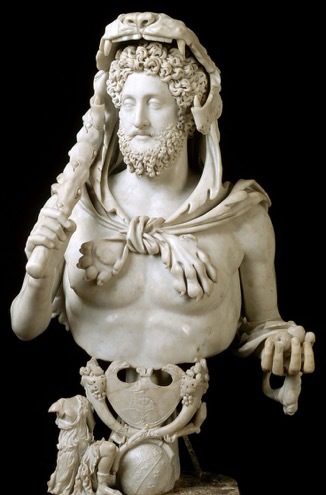Commodus as Hercules
Title
Date
Artist or Workshop
Materials
Height of the work
Provenience
Current Location
Sitter Biography
Description and Significance
This life-size, half-length bust of Commodus is composed of marble, giving it a polished white appearance throughout. The base of the bust contains a globe in the center, with the designs of the astrological symbols of Scorpio, Taurus, and Capricorn. Atop the globe are two crossed cornucopias, with a shield between them. The shield has two eagles curling around the top, and an image of Medusa on the front. To the right of the shield is a headless Amazonian woman. She is wearing sandals as well as a flowing dress, covering most of her chest. Atop the base, Commodus is portrayed with his chest bare. Clear muscular definition is evident around the chest. The right hand of the bust is slightly in front of the body, holding a large club which rests upon the right shoulder. The club has various small circles jutting from it. His left forearm is extended out, palm face up. He is clutching numerous small apples in this open hand. He is crowned with the pelt of a lion; the nose and mouth of the lion open around his forehead. The paws of the lion pelt are draped around his shoulders and tied at the center of his chest. Clear folds can be seen throughout the arms and back of the pelt (behind the neck of Commodus). Commodus is portrayed young, as there are very few wrinkles on the face of the bust. The head is tilted slightly to the right, giving the appearance of a deep gaze at some far away structure. The face is rather long and oval shaped while the lips are closed in a way that emanates a stern expression. The nose is large and slightly hooked at the end and the eyes are drilled with arched eyebrows above. A thick and full beard is present on the chin, with deeply drilled holes to help better define the myriad of curls. This beard connects to the hair on the head, which is carved in a similar style. The various drilled holes add volume to hair, making it appear very thick and layered.
Significance:
Commodus inherited Rome following a time of great peace and stability. Unfortunately, his decisions and madness led to a civil war and period of severe instability. Works such as this bust are evidence of his madness and portray why he was ultimately killed. Commodus believed himself to be the Greek demi-god Hercules. In this bust, he is portrayed in the guise of Hercules. He is shown in heroic nudity, wearing only the pelt of a lion on his head. Defeating the Nemean lion was one of the labors Hercules completed on his quest toward becoming divine. In addition, Commodus is resting a large club on his right shoulder, which was the choice weapon of Hercules. Finally, his left hand is clutching numerous apples, representing the golden apples of Hesperides. Stealing these apples was one of the final labors of Hercules. Commodus is representing himself here with all the various emblems of Hercules. By extension, he is presented with all the virtues of the demi-god as well. The inclusion of the apples of Hesperides are essential to this piece, as they represent Hercules at the end of his labors becoming immortal and divine. Commodus is depicting himself as immortal and divine as well; he has achieved this same status as Hercules and is on his way to becoming a god. This statue was originally flanked by two Tritons, one on each side, holding a curtain over the head of Commodus. These were meant to express his apotheosis, or elevation to divine status.
Commodus’s divine rule is further enforced through the base supporting the bust. A globe is on the bottom, with three zodiac symbols representing the month of October (The Bull, Capricorn, and Scorpion). This was a very significant month in the life of Commodus, as this was the month of his official accession to Rome. He even went so far as to rename the month Hercules. Commodus being atop the globe represents the global rule of the Roman Empire in addition to its’ protection under Commodus. An Amazon is kneeling next to the globe, and likely would have been originally mirrored on the other side. A Pelta is shown above the globe, which is a special type of Amazonian shield. Between the Pelta and globe are two crossed cornucopias. The kneeling Amazons and their shield portray the conquest over barbarians. Rome is presented atop these prisoners and spoils. Hercules fought against the Amazons during his labors, so Commodus chose to use them as a metaphor for the Barbarians which constantly were threatening Rome. The cornucopias represent abundance and the wealth of the Roman Empire. This bust acts not only as a display of Commodus’s divine aspirations, but a political statement on the strength of the Roman Empire. It should be noted that Commodus did not entirely abandon his familial history in his portraiture. The facial structure and full, curled, deeply drilled beard and hair are a direct link to his father, the previous emperor Marcus Aurelius. Commodus is depicting himself as Hercules, yet still highlighting his Antonine heritage
References
D.E.E.Kleiner. Roman Sculpture 1992 Yale University Press. pp. 275-277
Wind, Edgar. “In Defence of Composite Portraits.” Journal of the Warburg Institute, vol. 1, no. 2, 1937, pp. 138–142. JSTOR
Hannah, Robert. “The Emperor's Stars: The Conservatori Portrait of Commodus.” American Journal of Archaeology, vol. 90, no. 3, 1986, pp. 337–342. JSTOR, JSTOR
Tuck, Steven L. "A History of Roman Art". Wiley Blackwell. U.K 2015 pp. 251-254
Contributor
Citation
Item Relations
This item has no relations.

